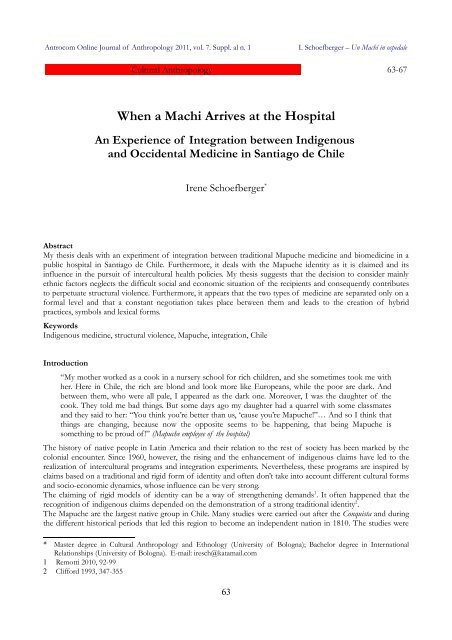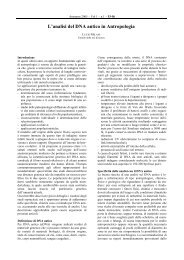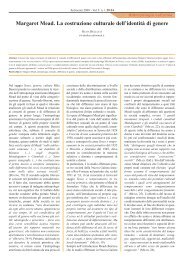When a Machi Arrives at the Hospital - Antrocom, Online Journal of ...
When a Machi Arrives at the Hospital - Antrocom, Online Journal of ...
When a Machi Arrives at the Hospital - Antrocom, Online Journal of ...
Create successful ePaper yourself
Turn your PDF publications into a flip-book with our unique Google optimized e-Paper software.
<strong>Antrocom</strong> <strong>Online</strong> <strong>Journal</strong> <strong>of</strong> Anthropology 2011, vol. 7. Suppl. al n. 1 I. Schoefberger – Un <strong>Machi</strong> in ospedale<br />
Cultural Anthropology 63-67<br />
<strong>When</strong> a <strong>Machi</strong> <strong>Arrives</strong> <strong>at</strong> <strong>the</strong> <strong>Hospital</strong><br />
An Experience <strong>of</strong> Integr<strong>at</strong>ion between Indigenous<br />
and Occidental Medicine in Santiago de Chile<br />
Irene Schoefberger *<br />
Abstract<br />
My <strong>the</strong>sis deals with an experiment <strong>of</strong> integr<strong>at</strong>ion between traditional Mapuche medicine and biomedicine in a<br />
public hospital in Santiago de Chile. Fur<strong>the</strong>rmore, it deals with <strong>the</strong> Mapuche identity as it is claimed and its<br />
influence in <strong>the</strong> pursuit <strong>of</strong> intercultural health policies. My <strong>the</strong>sis suggests th<strong>at</strong> <strong>the</strong> decision to consider mainly<br />
ethnic factors neglects <strong>the</strong> difficult social and economic situ<strong>at</strong>ion <strong>of</strong> <strong>the</strong> recipients and consequently contributes<br />
to perpetu<strong>at</strong>e structural violence. Fur<strong>the</strong>rmore, it appears th<strong>at</strong> <strong>the</strong> two types <strong>of</strong> medicine are separ<strong>at</strong>ed only on a<br />
formal level and th<strong>at</strong> a constant negoti<strong>at</strong>ion takes place between <strong>the</strong>m and leads to <strong>the</strong> cre<strong>at</strong>ion <strong>of</strong> hybrid<br />
practices, symbols and lexical forms.<br />
Keywords<br />
Indigenous medicine, structural violence, Mapuche, integr<strong>at</strong>ion, Chile<br />
Introduction<br />
“My mo<strong>the</strong>r worked as a cook in a nursery school for rich children, and she sometimes took me with<br />
her. Here in Chile, <strong>the</strong> rich are blond and look more like Europeans, while <strong>the</strong> poor are dark. And<br />
between <strong>the</strong>m, who were all pale, I appeared as <strong>the</strong> dark one. Moreover, I was <strong>the</strong> daughter <strong>of</strong> <strong>the</strong><br />
cook. They told me bad things. But some days ago my daughter had a quarrel with some classm<strong>at</strong>es<br />
and <strong>the</strong>y said to her: “You think you’re better than us, ‘cause you’re Mapuche!”… And so I think th<strong>at</strong><br />
things are changing, because now <strong>the</strong> opposite seems to be happening, th<strong>at</strong> being Mapuche is<br />
something to be proud <strong>of</strong>!” (Mapuche employee <strong>of</strong> <strong>the</strong> hospital)<br />
The history <strong>of</strong> n<strong>at</strong>ive people in L<strong>at</strong>in America and <strong>the</strong>ir rel<strong>at</strong>ion to <strong>the</strong> rest <strong>of</strong> society has been marked by <strong>the</strong><br />
colonial encounter. Since 1960, however, <strong>the</strong> rising and <strong>the</strong> enhancement <strong>of</strong> indigenous claims have led to <strong>the</strong><br />
realiz<strong>at</strong>ion <strong>of</strong> intercultural programs and integr<strong>at</strong>ion experiments. Never<strong>the</strong>less, <strong>the</strong>se programs are inspired by<br />
claims based on a traditional and rigid form <strong>of</strong> identity and <strong>of</strong>ten don’t take into account different cultural forms<br />
and socio-economic dynamics, whose influence can be very strong.<br />
The claiming <strong>of</strong> rigid models <strong>of</strong> identity can be a way <strong>of</strong> streng<strong>the</strong>ning demands 1 . It <strong>of</strong>ten happened th<strong>at</strong> <strong>the</strong><br />
recognition <strong>of</strong> indigenous claims depended on <strong>the</strong> demonstr<strong>at</strong>ion <strong>of</strong> a strong traditional identity 2 .<br />
The Mapuche are <strong>the</strong> largest n<strong>at</strong>ive group in Chile. Many studies were carried out after <strong>the</strong> Conquista and during<br />
<strong>the</strong> different historical periods th<strong>at</strong> led this region to become an independent n<strong>at</strong>ion in 1810. The studies were<br />
* Master degree in Cultural Anthropology and Ethnology (University <strong>of</strong> Bologna); Bachelor degree in Intern<strong>at</strong>ional<br />
Rel<strong>at</strong>ionships (University <strong>of</strong> Bologna). E-mail: iresch@k<strong>at</strong>amail.com<br />
1 Remotti 2010, 92-99<br />
2 Clifford 1993, 347-355<br />
63
<strong>Antrocom</strong> <strong>Online</strong> <strong>Journal</strong> <strong>of</strong> Anthropology 2011, vol. 7. Suppl. al n. 1 I. Schoefberger – Un <strong>Machi</strong> in ospedale<br />
carried out by Mapuche and non-Mapuche authors and <strong>of</strong>ten give <strong>the</strong> illusion <strong>of</strong> a basic cultural cohesion. It<br />
seems unlikely th<strong>at</strong> this cohesion has ever existed. However, it appears to be <strong>the</strong> ideal term to which social actors<br />
refer to. It is asserted by n<strong>at</strong>ive associ<strong>at</strong>ions and movements and by Mapuche poets and musicians, and <strong>the</strong>ir view<br />
is shared by <strong>the</strong> largest part <strong>of</strong> <strong>the</strong> Chilean society.<br />
My <strong>the</strong>sis tre<strong>at</strong>s different topics. The first is <strong>the</strong> Mapuche identity. Are <strong>the</strong>re any individual experiences th<strong>at</strong> differ<br />
from <strong>the</strong> traditional model? If so- do <strong>the</strong>y confirm <strong>the</strong> suppositions <strong>of</strong> some authors who claim th<strong>at</strong> <strong>the</strong>re isn’t<br />
any n<strong>at</strong>ive cultural peculiarity left? 3 Is it possible to find new hybrid forms?<br />
Secondly, my <strong>the</strong>sis tries to analyze how identity claims intervene in <strong>the</strong> conflicts <strong>of</strong> power th<strong>at</strong> mold<br />
intercultural health policies.<br />
Thirdly, it observes an experiment <strong>of</strong> integr<strong>at</strong>ion between two different types <strong>of</strong> medicine, so as to see if <strong>the</strong><br />
result is <strong>the</strong> maintenance <strong>of</strong> a separ<strong>at</strong>ion line or <strong>the</strong> development <strong>of</strong> collabor<strong>at</strong>ive forms. Does <strong>the</strong> experiment<br />
leave <strong>the</strong> opposition between <strong>the</strong> two elements untouched or does it help to cre<strong>at</strong>e new syncretic practices?<br />
The Mapuche Medical Service <strong>at</strong> <strong>the</strong> <strong>Hospital</strong> San Borja in Santiago<br />
The fieldwork was carried out from September to December 2010. It regarded mainly <strong>the</strong> Mapuche medical<br />
service th<strong>at</strong> is <strong>of</strong>fered <strong>at</strong> <strong>the</strong> hospital San Borja in Santiago de Chile since 2004. The San Borja is a hospital<br />
intended for <strong>the</strong> poorest clients <strong>of</strong> <strong>the</strong> N<strong>at</strong>ional Health Service. Most <strong>of</strong> <strong>the</strong> Indios living in <strong>the</strong> city are among<br />
<strong>the</strong>m.<br />
During <strong>the</strong> fieldwork, interviews and convers<strong>at</strong>ions were led with <strong>the</strong> machi (<strong>the</strong> healer), his assistant lawentuchefe,<br />
<strong>the</strong> Mapuche and non-Mapuche p<strong>at</strong>ients and some Mapuche and non-Mapuche executives <strong>of</strong> <strong>the</strong> hospital.<br />
Moreover, some <strong>the</strong>rapeutic encounters were observed. Simultaneously, I examined <strong>the</strong> public<strong>at</strong>ions regarding<br />
<strong>the</strong> development <strong>of</strong> <strong>the</strong> program. I also <strong>at</strong>tended an encounter between represent<strong>at</strong>ives <strong>of</strong> <strong>the</strong> N<strong>at</strong>ional Health<br />
Service and <strong>of</strong> some Mapuche associ<strong>at</strong>ions.<br />
A Mapuche pharmacy in Santiago is described. This pharmacy <strong>of</strong>fers products th<strong>at</strong> are inspired by <strong>the</strong><br />
indigenous medicine, but produced and sold according to extraneous guidelines.<br />
I also particip<strong>at</strong>ed to a meeting <strong>of</strong> traditional healers from all across L<strong>at</strong>in America with a mixed public <strong>of</strong><br />
Indians and Chileans.<br />
My <strong>the</strong>sis also deals with <strong>the</strong> narr<strong>at</strong>ions and <strong>the</strong> perspectives <strong>of</strong> individuals, so as to c<strong>at</strong>ch <strong>the</strong> forms <strong>the</strong>y give to<br />
<strong>the</strong> elements and to <strong>the</strong> processes <strong>the</strong>y get in touch with, according to <strong>the</strong>ir positions, intentions and<br />
rel<strong>at</strong>ionships. 4<br />
It observes how identity, as it is claimed, contributes to mold not only <strong>the</strong> spaces <strong>of</strong> <strong>the</strong> intercultural health<br />
service, but also <strong>the</strong> way <strong>of</strong> life and <strong>the</strong> cultural symbols <strong>of</strong> individuals. It also aims to observe <strong>the</strong> decisions and<br />
<strong>the</strong> positions <strong>of</strong> <strong>the</strong>se individuals.<br />
Sickness is an event th<strong>at</strong> leads individuals to be confronted with <strong>the</strong> symbols <strong>of</strong> <strong>the</strong> society <strong>the</strong>y belong to and to<br />
negoti<strong>at</strong>e with <strong>the</strong>m. 5<br />
I wanted to see how this happened in rel<strong>at</strong>ion to <strong>the</strong> Mapuche medical <strong>at</strong>tention in <strong>the</strong> hospital San Borja.<br />
Therefore it was necessary to observe <strong>the</strong> <strong>at</strong>titudes <strong>of</strong> <strong>the</strong> individuals toward identity claims and in which way<br />
<strong>the</strong> elabor<strong>at</strong>ion <strong>of</strong> cultural meanings is carried out by <strong>the</strong> involved individuals in an urban context.<br />
The formul<strong>at</strong>ion and <strong>the</strong> fulfillment <strong>of</strong> intercultural health policies are influenced by many social variables, by<br />
different interests, by conflicts <strong>of</strong> power and by mechanisms th<strong>at</strong> lead to an incorpor<strong>at</strong>ion <strong>of</strong> social inequalities. 6<br />
This incorpor<strong>at</strong>ion can be found in <strong>the</strong> case <strong>of</strong> <strong>the</strong> Mapuche, who belong to a n<strong>at</strong>ive group and to <strong>the</strong> poorest<br />
and most marginalized part <strong>of</strong> a society marked by deep classism. 7<br />
However, <strong>the</strong> health program dedic<strong>at</strong>ed to <strong>the</strong>m gives importance only to <strong>the</strong>ir ethnic identity. My <strong>the</strong>sis<br />
investig<strong>at</strong>es if <strong>the</strong> decision to give absolute priority to <strong>the</strong> Mapuche identity may lead to consequences in <strong>the</strong><br />
realiz<strong>at</strong>ion and in <strong>the</strong> results <strong>of</strong> <strong>the</strong> program.<br />
As I was approaching <strong>the</strong> program, two subjects emerged immedi<strong>at</strong>ely: <strong>the</strong> Mapuche medicine and <strong>the</strong><br />
biomedicine. Both took form as closed systems, which are separ<strong>at</strong>ed by limits <strong>of</strong> contents. The purpose <strong>of</strong> my<br />
<strong>the</strong>sis was to observe <strong>the</strong> impact <strong>of</strong> this <strong>the</strong>oretical opposition on individual experiences.<br />
3 Saavedra Peláez 2002, 208<br />
4 Balandier 1973, 34-43; Barth 1989, 132-134; Geertz 1987, 114<br />
5 Schirripa & Vulpiani 2000, 245<br />
6 Castro e Singer 2004, XIV-XVIII; Farmer 2003<br />
7 Saavedra Peláez 2002, 141-147<br />
64
<strong>Antrocom</strong> <strong>Online</strong> <strong>Journal</strong> <strong>of</strong> Anthropology 2011, vol. 7. Suppl. al n. 1 I. Schoefberger – Un <strong>Machi</strong> in ospedale<br />
Hybrid Identities<br />
The observed case takes place in an already syncretic situ<strong>at</strong>ion, because it is based on <strong>the</strong> meeting <strong>of</strong> an<br />
indigenous <strong>the</strong>rapeutic tradition with a new kind <strong>of</strong> organiz<strong>at</strong>ion.<br />
Sometimes <strong>the</strong> syncretism <strong>of</strong> this medical service increases <strong>the</strong> syncretism <strong>of</strong> <strong>the</strong> involved personal identities.<br />
Almost all <strong>of</strong> <strong>the</strong> interviewed Mapuche had emigr<strong>at</strong>ed to Santiago in <strong>the</strong>ir childhood: in <strong>the</strong>ir experience,<br />
indigenous elements are mixed to non-indigenous ones.<br />
It is important to remark th<strong>at</strong> <strong>the</strong> indigenous elements don’t have a fixed form: although <strong>the</strong> discrimin<strong>at</strong>ions<br />
suffered by <strong>the</strong>ir parents <strong>of</strong>ten induce <strong>the</strong> Mapuche not to transmit <strong>the</strong>ir n<strong>at</strong>ive cultural knowledge, <strong>the</strong>y still<br />
maintain parts <strong>of</strong> it. The emigr<strong>at</strong>ion to <strong>the</strong> city encloses <strong>the</strong> loss <strong>of</strong> contact with o<strong>the</strong>r Indians and <strong>the</strong><br />
exposition to discrimin<strong>at</strong>ion. It also may include experiences such as mixed marriages and conversions to<br />
Christianity.<br />
All <strong>the</strong>se factors led <strong>the</strong> interviewed persons to an estrangement from <strong>the</strong>ir traditional identity, which had been<br />
bound to <strong>the</strong> rural world.<br />
Never<strong>the</strong>less, <strong>the</strong> medical <strong>at</strong>tention <strong>of</strong>fered in <strong>the</strong> hospital induced many <strong>of</strong> <strong>the</strong>m to approach it again. A<br />
Mapuche executive <strong>of</strong> <strong>the</strong> San Borja argues th<strong>at</strong> this rediscovery is based on <strong>the</strong> acknowledgement <strong>of</strong> <strong>the</strong>ir<br />
origins. The word “origins” is revealing, because it suggests a dialogic rel<strong>at</strong>ion between individuals and cultural<br />
meanings. The contact with <strong>the</strong> machi represents for many p<strong>at</strong>ients <strong>the</strong> first direct contact with <strong>the</strong> Mapuche<br />
medicine, but <strong>the</strong>re are o<strong>the</strong>r elements in <strong>the</strong>ir live and educ<strong>at</strong>ion th<strong>at</strong> may combine with <strong>the</strong> indigenous ones<br />
and induce <strong>the</strong>m to adopt new syncretic points <strong>of</strong> view or to become critical toward solutions th<strong>at</strong> appear to be<br />
anachronistic or inefficient. This can partially be seen in <strong>the</strong> narr<strong>at</strong>ives <strong>of</strong> <strong>the</strong> Mapuche who are involved in<br />
movements for identity claims: although <strong>the</strong>y emphasize a strong adhesion to <strong>the</strong>ir traditional identity, <strong>the</strong>y use a<br />
vocabulary and express life-styles th<strong>at</strong> are quite different from it.<br />
All <strong>the</strong>se consider<strong>at</strong>ions lead to <strong>the</strong> conclusion th<strong>at</strong> <strong>the</strong> Mapuche identity is <strong>the</strong> always-changing fruit <strong>of</strong> an<br />
uninterrupted process <strong>of</strong> syncretism, innov<strong>at</strong>ion and reconstruction.<br />
Hybrid Practices<br />
Traditional identity has been assumed as <strong>the</strong> point <strong>of</strong> departure for <strong>the</strong> cre<strong>at</strong>ion <strong>of</strong> <strong>the</strong> health program.<br />
However, its realiz<strong>at</strong>ion intertwines <strong>the</strong> guidelines with <strong>the</strong> cultural perspectives <strong>of</strong> all involved individuals. The<br />
<strong>the</strong>rapeutic practices <strong>of</strong> <strong>the</strong> machi aren’t just traditional: <strong>the</strong>y imply some innov<strong>at</strong>ive aspects th<strong>at</strong> seem to derive<br />
partially from biomedicine. An example can be seen in <strong>the</strong> large confidence accorded to <strong>the</strong> effectiveness <strong>of</strong><br />
herbal components, which – confronted to <strong>the</strong> supern<strong>at</strong>ural ones – seem to be nearer to occidental scientific<br />
standards. 8 This happens for example in <strong>the</strong> case <strong>of</strong> a Mapuche pharmacy in Santiago, which was cre<strong>at</strong>ed by<br />
some machis and doctors <strong>of</strong> a hospital in <strong>the</strong> south <strong>of</strong> Chile. This pharmacy sells herbal prepar<strong>at</strong>ions th<strong>at</strong> refer to<br />
<strong>the</strong> n<strong>at</strong>ive pharmacopoeia. But <strong>the</strong>y are produced in conformity to scientific rules and are distributed through an<br />
occidental selling-model.<br />
Sometimes, hybrid symbols and meanings appear in <strong>the</strong> individual narr<strong>at</strong>ives and explan<strong>at</strong>ions concerning<br />
diseases. The case <strong>of</strong> a woman who says to suffer <strong>at</strong> <strong>the</strong> same time from diabetes and brujeria is exemplary.<br />
Intercultural Health Policies and Structural Violence<br />
The importance given to identity in comparison to o<strong>the</strong>r factors molds <strong>the</strong> form assumed by health policies and<br />
particip<strong>at</strong>es in <strong>the</strong> cre<strong>at</strong>ion <strong>of</strong> spaces, symbols and meanings. This happens even if <strong>the</strong> users <strong>of</strong> <strong>the</strong> service live<br />
in a very difficult socio-economic condition.<br />
By paying only little <strong>at</strong>tention to <strong>the</strong> socio-economic factors, <strong>the</strong> program risks to perpetu<strong>at</strong>e social economic<br />
inequality. If it doesn’t recognize <strong>the</strong> existence <strong>of</strong> <strong>the</strong>se inequalities, it won’t be able to solve <strong>the</strong>m. As <strong>the</strong><br />
president <strong>of</strong> <strong>the</strong> indigenous executives <strong>at</strong> <strong>the</strong> hospital argues, <strong>the</strong> classism <strong>of</strong> <strong>the</strong> Chilean society leads up to <strong>the</strong><br />
fact th<strong>at</strong> a program designed above all for <strong>the</strong> Indians is administr<strong>at</strong>ed only by non-indigenous functionaries.<br />
Even if <strong>the</strong> planning stage <strong>of</strong> <strong>the</strong>se health policies doesn’t take account <strong>of</strong> some influent socio-economic<br />
variables, <strong>the</strong>y intervene in <strong>the</strong> realiz<strong>at</strong>ion <strong>of</strong> <strong>the</strong> program. At <strong>the</strong> same time, some interventions are made to<br />
remedy <strong>the</strong>ir neg<strong>at</strong>ive effects: a Mapuche executive expresses her hope th<strong>at</strong> <strong>the</strong> newly cre<strong>at</strong>ed associ<strong>at</strong>ion for <strong>the</strong><br />
8 Schirripa & Vulpiani 2000, 16<br />
65
<strong>Antrocom</strong> <strong>Online</strong> <strong>Journal</strong> <strong>of</strong> Anthropology 2011, vol. 7. Suppl. al n. 1 I. Schoefberger – Un <strong>Machi</strong> in ospedale<br />
indigenous workers <strong>at</strong> <strong>the</strong> hospital will help n<strong>at</strong>ive medicine to achieve its legitim<strong>at</strong>ion. She also hopes th<strong>at</strong> n<strong>at</strong>ive<br />
medicine will contribute to render hospital tre<strong>at</strong>ment more human, especially in <strong>the</strong> case <strong>of</strong> individuals who<br />
suffer from discrimin<strong>at</strong>ion not only because <strong>of</strong> <strong>the</strong>ir ethnic identity, but also and mostly because <strong>of</strong> <strong>the</strong>ir rural<br />
origin, <strong>of</strong> <strong>the</strong>ir clo<strong>the</strong>s, <strong>of</strong> <strong>the</strong>ir habits and <strong>of</strong> <strong>the</strong>ir communic<strong>at</strong>ion problems.<br />
Separ<strong>at</strong>ion and Collabor<strong>at</strong>ion<br />
Traditional identity also influences <strong>the</strong> perception <strong>of</strong> <strong>the</strong> indigenous world held by non-Mapuche p<strong>at</strong>ients. This<br />
perception differs widely from <strong>the</strong> way <strong>the</strong> n<strong>at</strong>ive persons perceive <strong>the</strong>mselves. It seems to witness <strong>the</strong> cre<strong>at</strong>ion<br />
<strong>of</strong> a new identity, which selects some indigenous cultural forms and elev<strong>at</strong>es <strong>the</strong>m to symbols <strong>of</strong> a radical<br />
opposition to an industrialized and capitalist world. In this perspective, Mapuche culture is considered<br />
prestigious, due to its old traditions and to <strong>the</strong> presence <strong>of</strong> some <strong>of</strong> its elements in Chilean culture.<br />
The wide group <strong>of</strong> practices and subjects th<strong>at</strong> is generally defined as “occidental culture” reveals itself to be less<br />
monolithic than it may seem.<br />
On a formal level, <strong>the</strong> rel<strong>at</strong>ion between both <strong>the</strong>rapeutic traditions is one <strong>of</strong> separ<strong>at</strong>ion, as <strong>the</strong> interviewed<br />
persons st<strong>at</strong>e it. Anyway, a negoti<strong>at</strong>ion takes place in <strong>the</strong> encounter between machi and p<strong>at</strong>ients. Health practices<br />
and medical vocabulary are changing.<br />
The machi describes how his function in <strong>the</strong> city differs from <strong>the</strong> healer’s work in <strong>the</strong> south <strong>of</strong> Chile. Differences<br />
such as minor prestige, lack <strong>of</strong> time and <strong>the</strong> necessity to accept also non-indigenous p<strong>at</strong>ients are <strong>the</strong> results <strong>of</strong> a<br />
new situ<strong>at</strong>ion. The healer partially adapts his <strong>the</strong>rapeutic explic<strong>at</strong>ions to <strong>the</strong> biomedical lexicon and begins to use<br />
words like “depression” or “psychological problem”. The narr<strong>at</strong>ives <strong>of</strong> his assistant and <strong>of</strong> <strong>the</strong> p<strong>at</strong>ients are also<br />
hybrid. The p<strong>at</strong>ients’ narr<strong>at</strong>ives are quite various, because <strong>the</strong>y are medi<strong>at</strong>ed by <strong>the</strong>ir personal processing, in<br />
which <strong>the</strong>y project both individual and collective represent<strong>at</strong>ions <strong>of</strong> <strong>the</strong> society <strong>the</strong>y belong to. While a Mapuche<br />
p<strong>at</strong>ient describes her sickness and <strong>the</strong> efforts she made in <strong>the</strong> past to fight <strong>the</strong> evil eye given her by someone,<br />
o<strong>the</strong>r non-indigenous p<strong>at</strong>ients refer mostly to <strong>the</strong> serenity <strong>the</strong>y feel during <strong>the</strong> ritual, to <strong>the</strong> herbal prepar<strong>at</strong>ions<br />
and to <strong>the</strong> alimentary recommend<strong>at</strong>ions <strong>the</strong>y receive.<br />
On a formal level, <strong>the</strong> separ<strong>at</strong>ion between <strong>the</strong> two types <strong>of</strong> medicine is also caused by power conflicts th<strong>at</strong><br />
produce disputes <strong>of</strong> legitim<strong>at</strong>ion. On an informal level, p<strong>at</strong>ients seem to find <strong>the</strong> new hybrid practices n<strong>at</strong>ural<br />
and reassuring; <strong>the</strong>y also express <strong>the</strong> belief th<strong>at</strong> <strong>the</strong> collabor<strong>at</strong>ion between machis and doctors increases <strong>the</strong>ir<br />
confidence in both.<br />
In <strong>the</strong> future, it will be possible to observe <strong>the</strong> effects <strong>of</strong> <strong>the</strong> rapprochement to traditional cultural forms now<br />
experienced by many people. In many cases it derives from <strong>the</strong> integr<strong>at</strong>ion <strong>of</strong> Mapuche practices in health or<br />
educ<strong>at</strong>ion services. It will be possible to see if this rapprochement, th<strong>at</strong> now appears to be deeply syncretic, will<br />
continue to produce new forms and represent<strong>at</strong>ions or if <strong>the</strong> strong action <strong>of</strong> identity claims and <strong>the</strong> relevance<br />
accorded to <strong>the</strong>m by <strong>the</strong> institutions and <strong>the</strong> public opinion, will render it mainly a recovery process <strong>of</strong> rigid<br />
traditional contents.<br />
66
<strong>Antrocom</strong> <strong>Online</strong> <strong>Journal</strong> <strong>of</strong> Anthropology 2011, vol. 7. Suppl. al n. 1 I. Schoefberger – Un <strong>Machi</strong> in ospedale<br />
References<br />
Balandier G. 1971. Sens et Puissance. Les Dinamique sociales. Paris. Ed. italiana 1973, Le società comunicanti. L<strong>at</strong>erza,<br />
Bari.<br />
Barth F. 1989. The analysis <strong>of</strong> culture in complexe societies. Ethnos, num. 54<br />
Castro A. & Singer M. 2004. Unhealthy health policy: a critical anthropological examin<strong>at</strong>ion. Altamira Press, Oxford.<br />
Clifford J. 1988. The predicament <strong>of</strong> culture: twentieth century ethnography, liter<strong>at</strong>ure and art. Harvard. Ed. italiana 1993 I<br />
frutti puri impazziscono: etnografia, letter<strong>at</strong>ura e arte nel secolo XX. Boll<strong>at</strong>i Boringhieri, Torino.<br />
Farmer P. 2003. P<strong>at</strong>hologies <strong>of</strong> power: health, human rights and <strong>the</strong> new war on <strong>the</strong> poor. University <strong>of</strong> California Press,<br />
Berkeley.<br />
Geertz C., 1973. The interpret<strong>at</strong>ion <strong>of</strong> cultures: selected essays. New York. Ed. Italiana 1987. Interpretazione di culture. Il<br />
Mulino, Bologna.<br />
Remotti F. 2010. L’ossessione identitaria. L<strong>at</strong>erza, Roma- Bari.<br />
Saavedra Peláez A. 2002. Los Mapuche en la sociedad chilena actual. LOM Ediciones, Santiago del Cile<br />
Schirripa P. & Vulpiani P. 2000. L’ambul<strong>at</strong>orio del guaritore: forme e pr<strong>at</strong>iche del confronto tra biomedicina e medicine<br />
tradizionali in Africa e nelle Americhe. ARGO editrice, Lecce.<br />
67
















